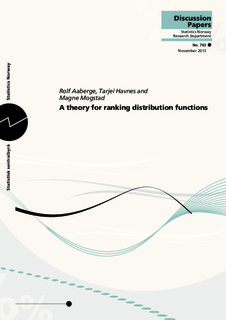| dc.description.abstract | When is one distribution (of income, consumption, or some other economic variable) more equal or better than another? This question has proven difficult to answer in situations where distribution functions intersect and no unambiguous ranking can be attained without introducing weaker criteria than second-degree stochastic dominance. The conventional approach in empirical work is to adopt some summary statistics, with no explicit reason being given for preferring one measure rather than another. In this paper, we develop a theory for ranking distribution functions. Our theory offers a general framework to unambiguously rank any set of distribution functions and quantify the social welfare level of a dominating distribution as compared to a dominated distribution. The framework is based on two complementary sequences of nested dominance criteria. The first (second) sequence extends second-degree stochastic dominance by placing more emphasis on differences that occur in the lower (upper) part of the distribution. These sequences of dominance criteria characterize two separate systems of nested subfamilies of social welfare functions. This allows us to identify the least restrictive social preferences that give an unambiguous ranking of any set of distribution functions. We also provide an axiomatization of the sequences of dominance criteria and the corresponding subfamilies of social welfare functions. To perform inference, we develop asymptotic distribution theory for empirical dominance criteria where it is demonstrated that the associated empirical processes converge in distribution to Gaussian processes. The usefulness of our framework is illustrated with two empirical applications; the first assesses the social welfare implications of changes in household income distributions over the business cycle, while the second ranks the actual and counterfactual outcome distributions from a policy experiment. | nb_NO |
